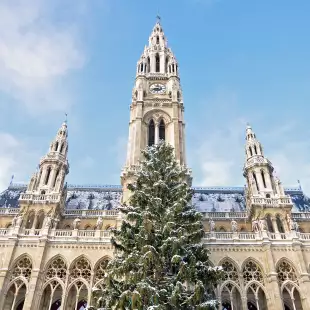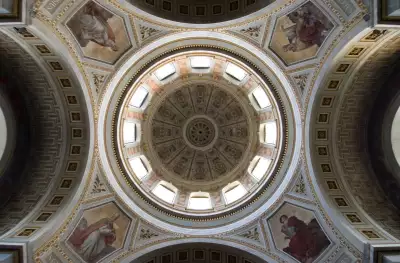A Musical Tour of the Danube

Read more about the history of musicians from Hungary, Austria, and Germany.
Scenic landscapes and awe-inspiring vistas have provided composers with musical muses throughout the years, leading to many compositions that can evoke images of sunny skies over rolling hills or bitter winter nights. Certain cities along the Danube have acted as hubs for musical creativity, attracting a number of prominent classical composers over the centuries who were inspired by each other in one way or another.

One of the most prolific and well-known classical composers was born and raised by the waters of the nearby Salzach river in the Baroque city of Salzburg. Mozart’s father was a minor composer and a violinist for the ruling Prince-Archbishop of Salzburg at the time. He introduced a very young Mozart to the keyboard, who took to it immediately and was composing his own pieces by the time he was around four or five.
Mozart’s youth was spent travelling with his family to perform in various different countries before becoming employed as a court musician around 1773 by the then ruler of Salzburg. But it was in his later years that Mozart’s prodigious talent was brought to light through the compositions produced during his time spent in Vienna. It was here that Mozart decided to resign from his post in Salzburg and take up being a freelance performer and composer, a step that would go on to shape his future greatly.
Mozart went on to spend many successful years living in Vienna and enjoyed an extensive career that’s still celebrated to this day, as shown by the statue outside the Hofburg Palace in his honour. His final symphony, nicknamed the Jupiter Symphony, is one that Mozart may have never heard performed personally. However, the overwhelmingly positive reception to this piece by critics earned it the title of masterwork – a symphony that would stand as a testament to Mozart’s peerless talent.

Johann produced what might be the single most recognisable piece of classical music there is – The Blue Danube. Although the name might elude you, this piece has been featured in countless pieces of media over the years such as 2001: A Space Odyssey, the ball scene in Titanic and a rather famous Monty Python sketch.
Its consistent popularity coupled with affinity the Viennese people feel towards the melody have led to the composition becoming the unofficial Austrian national anthem. Although the instrumental version has come to be the one most well-known rendition of the piece, it originally had words associated with it. These lyrics clearly resound the fondness felt toward the Danube and its natural beauty, a feeling many Viennese residents could relate to.

Beethoven possessed talent of such magnitude and a career of such scope that transcends the limitations that were imposed upon his hearing during his later years. He entered Vienna as a young man after he spent his formative years in the German city of Bonn. His talent had burned bright from a young age and was noticed by his father while receiving tutelage, something Beethoven and Mozart had in common.
He was later introduced to Joseph Haydn – one of Mozart’s notable collaborators – who still resided comfortably within the Austrian capital. During one of his frequent trips to London, Haydn made a stop in Bonn where he and Beethoven met and later arranged for the young composer to learn from the old master. It was with Haydn as a trusted mentor where Beethoven’s career flourished and matured within Vienna’s vibrant musical landscape.
Many of Beethoven’s pieces became highly popular, notably his “Für Elise”, “Moonlight Sonata” and Fifth Symphony, cementing him as a successor to the widely celebrated composers that came before and helped fill the hole that Mozart’s death left. Over time, he became as revered as the man he was expected to fill the shoes of, with Beethoven’s impressive legacy living on within the renditions of his music by contemporary orchestras across Vienna and the world over.

A musical tour of the Danube wouldn’t be complete without featuring the timeless classic The Sound of Music, a theatrical musical with almost universal appeal and tunes that you end up humming for days on end. Based on the real-life events surrounding the Trapp Family Singers, the success of the stage and screen adaptations of Maria von Trapp’s memoirs have thrilled and fascinated all that come in contact with the story.
In the film, Villa Von Trapp is represented by Schloss Frohnburg, a gorgeous Salzburg country castle, and Schloss Leopoldskron, an idyllic palace with equally enchanting grounds. However, the real Villa Trapp is found in Aigen – a suburb located in Salzburg’s Old Town – which now contains an extensive Sound of Music exhibition as well as a luxurious hotel!
One of the film’s most beloved songs, ‘Do-Re-Mi’, was shot along a route through Salzburg that starts at a picnic on the Monchsberg Cliffs and ends with the cast exploring the Mirabell Palace and Gardens. Picking out these locations is a fantastic way to see the city and check out the places where the real Von Trapp family potentially visited in their early lives.
Each of these musical presences has had profound effects on the cities surrounding them and can be seen as you stroll along the streets, with statues and concert halls still ringing with their melodies. You can feel the tangible effect in the towns and cities along the Danube, where it’s waters inspired musical compositions and was home to a number of the world’s most famous musicians.
Why not try a river cruise along the Danube, or maybe an escorted tour of Prague, Vienna, Bohemia & the Danube Valley.
If you have any questions, please do not hesitate to contact us.



















